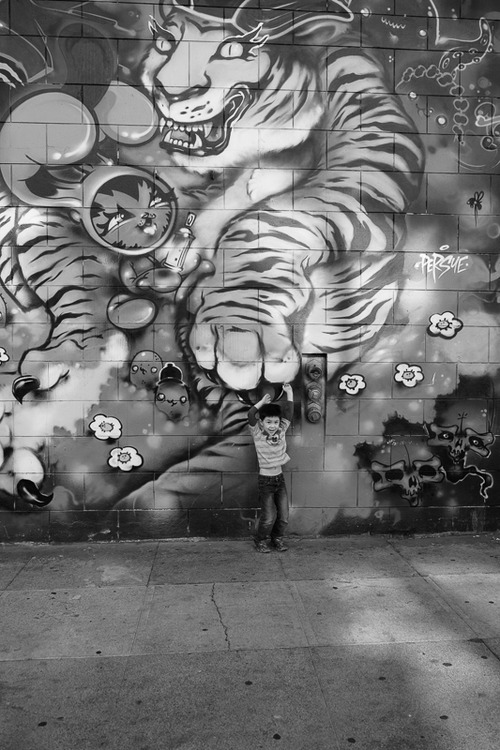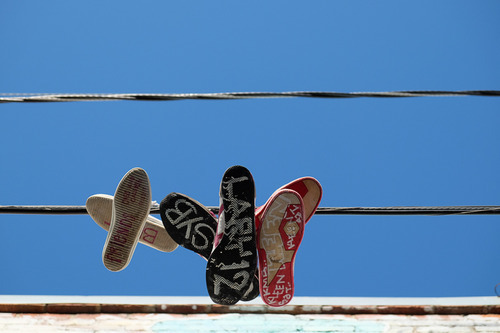Since my last post, I had the chance to take the XE-2 outside on two different occasions.
Autofocus. AF has seen definitely seen a big improvement over the X-E1, and in good light outdoors the improvement is even more noticeable (likely because of the PDAF). That being said, I did notice a good number of my “chasing kids” shots were still out of focus. Even in single-shot AF, with a fixed focus box, I got shots that were back-focused. I tried various sizes for the focus box, and it didn’t really help.
My suspicion after playing with it is that Fuji still hasn’t quite figured out how to pick a focus point within a certain area. If the focus box is 75% covered by a face, and 25% the background, I’d expect it to focus on the face (or other closer subject), but it appears not to. It seems like it wants to just pick the area of the box which has the most signal, which is not necessarily what you want.
All in all though, I think as long as you’re not shooting very rapidly moving subjects, the AF is definitely acceptable. If you are shooting things like kids, then it’s not quite there yet. I think my two year old GH2 can still get more shots in focus.
EVF lag. My experience with the viewfinder was surprising. While the frame-rate is definitely improved, both the EVF and the rear LCD seem to have inconsistent, unpredictable behavior. For example, sometimes, even in super bright outdoor light, you could see the frame-rate start to drop. But by far the worst issue is that the live view feed seems to stop for a good half a second when the shutter is half-depressed. I think all X-series cameras do this, and it really drives me bonkers.
I’m often trying to keep the focus box over my kid’s face as the focus system tries to lock on. But as soon as I engage the shutter to start the focus, BAM, it hiccups. By the time it shows me what’s going on again, I’ve totally lost the framing, and its a good bet that whatever was behind my subject is now in focus.
I tried to combat this by using the “mash the shutter button and pray” technique, but I still couldn’t get a good hit rate. I even tried burst mode with continuous AF. The problem is that if the subject is moving around a lot, you really need a fluid display so that you can maintain the framing. The X-E2 simply does not let you do this at all. As shots are being fired, the EVF is all kinds of herky jerky. When it calms down, you get your smooth frame rate again, but by then it’s too late.
Perhaps it would be better to use multi-AF, but after some quick experimentation with that, I couldn’t trust it to focus on the obvious subjects in the view.
Color. The JPEG renderings that come out of this camera are awesome. I didn’t get a chance to play with RAW much because I didn’t want to mess with the LR beta or the other random tools out there that supposedly deal with X-Trans. I ended up taking a bunch of family shots, and people I showed them definitely noticed a more pleasant rendering compared to my previous GH2 shots (which even has my own RAW tweaks. I guess the Fuji engineers are better at this than me :P).
One issue that I did notice was the default NR seems quite strong, especially if you get into the iso3200-6400 range. Faces come out plastic-y, void of any skin texture. All my custom modes ended up having NR set to -1 to compensate for this.
Which brings me to another minor operational complaint. When I use the Q menu to select a custom profile, then shut the camera off (to save battery) and then turn it on soon after, I get stuck back into the “basic” profile (where my NR level gets reset). Why? For a camera that seems to really prioritize persistent settings (having physical dials for a bunch of stuff is as persistent as you can be), I just could not understand why this behavior should different.
I also had a lot of fun shooting in the black and white modes. I tended to use the green filter for portraits, and the red filter for other stuff. It’s really fun to be able to see the result in the live view. I think you could do this with the X-E1 as well, but perhaps I was just not into B&W as much then. The B&W output looks exceptional though. I almost wonder if they have some special demosaicing trick they do for BW that differs from color.
One thing that comes up with BW modes is dynamic range. While I found the metering of the camera to be pretty good, it tends to render shadow areas quite darkly in high contrast scenes. I ended up using the shadow tone -1 setting minus one to lift the shadows a bit, but then I was still often victim of the forgotten profile setting I mentioned above.
Overall, I’d say that the X-E2 a big improvement from the X-E1. It fixes some of the plain terrible issues that the X-E1 had around auto focus and EVF lag. It also feels speedier and more refined. The image quality is also still top notch. The stuff that comes out of this APS-C sensor is pretty amazing.
All that being said, it still isn’t better enough to really fit my needs. A vast majority of my photos are candids of my kids. And while the X-E2 can keep up with them if they’re in a particularly calm mood (or are sitting at the table for a meal, for example), most other scenarios end up with a lot of hail-mary shutter presses. When the AF happened to lock on the right thing.. the result was usually awesome. But more often then not the focus missed, or the framing was just completely off, because of jerkiness of the live view when focusing.
One way to categories cameras is to think about what kind of design philosophy they embody. XE-2’s (and basically other X-series cameras) seem to derive more from the rangefinder school of thought. These types of cameras tend to be used by folks who are somewhat considered in their photography. The X-series appeals to these folks through lots of manual controls (even if it means less efficient switching between different shooting situations) and a focus on non-action image quality.
On the other end of the spectrum is of course the DSLR. Usually ugly, but high performance. They have some manual control to give you some creative dimensions, but also a lot of smarts to pick good parameters when you have to think fast. Great AF that lets you keep up with a fast-changing scene.
From this perspective, the GH2 I’ve been using is clearly a DSLR-ish camera. It even looks like one. I think much of my dissatisfaction stems from the fact that I want DSLR-like handling out of a RF-ish camera.
I also don’t like having two different camera systems for two different purposes. So if I only get to pick one, then given the kinds of photos I need to take, I have to go with the DSLR-like philosophy.
So I’m sending the X-E2 back and getting an E-M1.
I’m sure I’ll miss the high quality jpegs and the great low-light performance, but honestly, I’ll very likely get way more keepers with the E-M1, and that’s what matters. Maybe in a few more years, the Fuji cams will really perform like fast DSLR’s, but I’m not willing to muddle along and miss a bunch of shots of my kids in the mean time. Also, by then, some of this FF mirrorless stuff will have played out, and the landscape may look quite different. I’m also somewhat relieved that I don’t need to figure out a new X-Trans RAW workflow. The E-M1 will fit right in to my existing Lightroom habits.
Anyways, see below for some of the better shots I got (note how most of them are non-moving subjects).
I’ll be back to blab more about the E-M1 in a few days.




